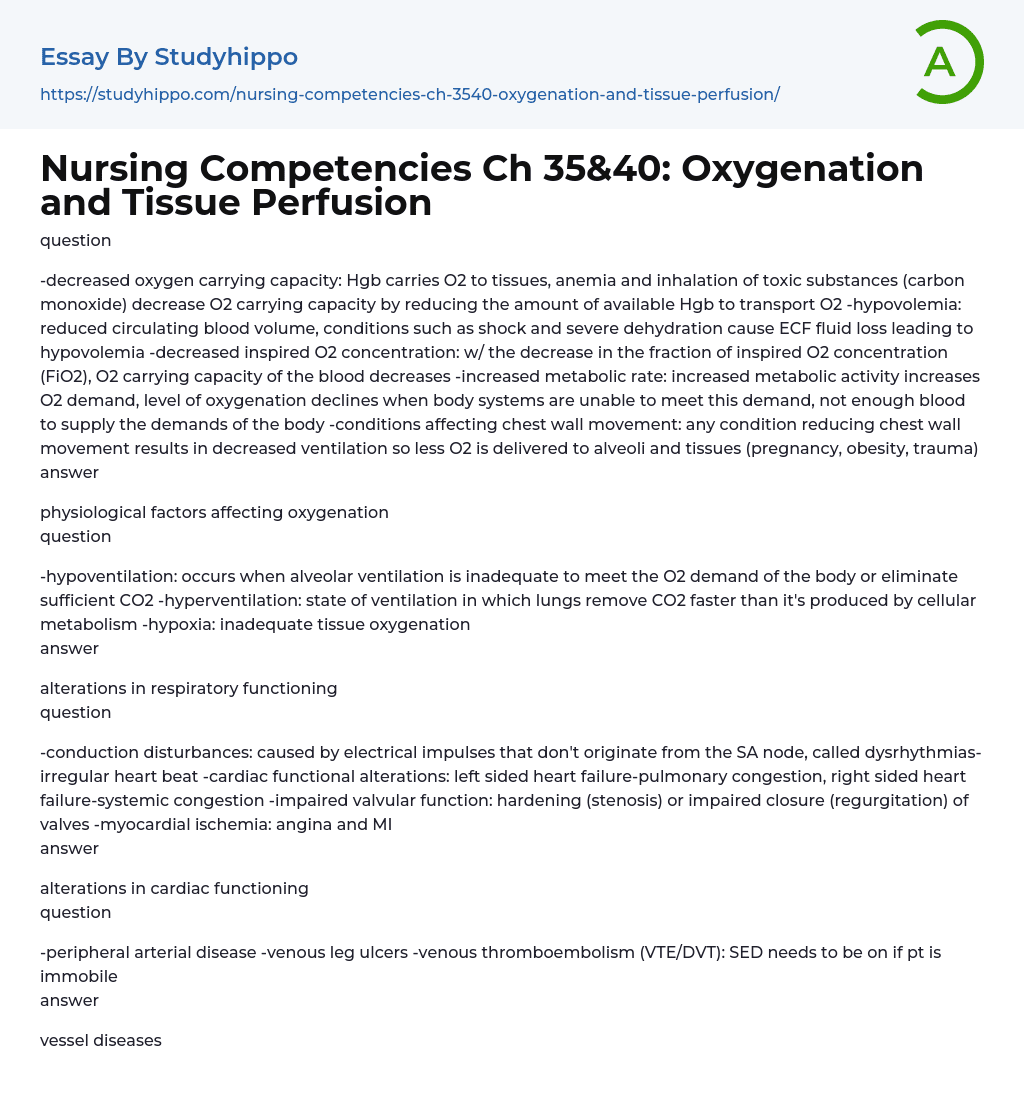

Nursing Competencies Ch 35&40: Oxygenation and Tissue Perfusion Essay Example
when alveolar ventilation is inadequate to meet the O2 demand of the body or eliminate sufficient CO2 -hyperventilation: state of ventilation in which lungs remove CO2 faster than it's produced by cellular metabolism -hypoxia: inadequate tissue oxygenation
to be on if pt is immobile
percussion 4. auscultation: cardiac sounds (irregular, murmurs, bruits), lung sounds (crackles, wheezing); normal (S1, S2, ventricular sound) special-assessment of hypoxia (tissue deprived of air) -LOC: restlessness, appear nervous, may become confused later on -capillary refill is slow -skin color and temp: pallor (pale) -respiration: tachypneic at 1st, develop bradypnea later on -respiratory distress: use of accessory muscles, nasal flaring, tracheal tugging (can see the trachea moving), lung sounds, panic/anxiety, VS, early vs late
in to drain fluid or allow air to escape -ECG: picture of electrical activity of heart -echocardiogram: assesses mechanical activity of the heart -cardiac catheterization: done if pt has chest pain, determines if someone has a blockage in coronary artery -pulmonary function test (PFT) or spirometry: tests lung volume and ability to exhale -stress test -imaging: chest X-ray (CXR)-look at size of heart, tumors, diaphragm, used check if central line or tracheal tube are in the right place, detects atelectasis
exhausted when ambulating to bathroom, "I'm just too tired to shower now" -interventions: space out activities to give pt periods of rest
long term, mouth care is important, need to use 4x4 w/ a slit for trach tubes (fenestrated); tracheotomy-stoma 1. outside cannula 2. obturator 3. suctioning-sterile procedure, suction on the way out of tube 4.
tracheostomy care 5. accidental decannulation
partial non-rebreather mask w/ reservoir bag: 60-70% FiO2 at flow rates of 6-10 LPM (keep bag inflated) 4. non-rebreather mask: 60-80% FiO2 at 10-15 LPM, highest amount of O2 that can be delivered, be prepared to intubate pt (ET tube) if using this system 5. venturi mask: 24-60% FiO2 at flow rates of
4-12 LPM, can control O2, delivers most precise dose of O2 6. face tent: 24-100% FiO2 at flow rates > 10 LPM, provides high level of humidification 7. noninvasive continuous positive airway pressure (CPAP/BiPAP): patients sleep w/ this at night, sealed around mouth, keeps tissue in the mouth pushed to the sides so obstruction doesn't occur, for people w/ obstructive sleep apnea
851)
engulf the bacteria but can't destroy it, necrosis occurs and the body seals it off creating granulomas in the lungs, TB bacteria causes death of tissue in the organs they infect
pt teaching
CO alterations, alterations in circulating blood, alterations in peripheral vessels, alterations in cerebral vessels
more per min)
synchronized cardioversion
workload of the heart and O2 demand; Sx: weight gain, distended neck veins, congestion in organs, hepatomegaly, splenomegaly and large kidneys due to fluid build up, peripheral edema (feet and legs) -cardiogenic shock: heart can't pump enough blood to meet the body's needs
at rest, spasm of coronary artery -unstable: caused by the rupture of thickened plaque, angina w/ increased frequency, duration and severity, occurs even at rest, isn't relieved w/ nitroglycerin
artery & past the blockage, when in place, the balloon is inflated, the inflation of the balloon compresses the fatty tissue in the artery and makes a larger opening inside the artery for improved blood flow -smoking cessation medications -ASA -ACEI or ARB -beta blocker -statin
-occult blood: hemoccult, gastroccult -meds -pt teaching and pt safety
cessation, physical exercise, ideal body weight, tight glucose control, tight BP control, hyperlipidemia
assess: identify high risk patients, leg pain, chest pain 2. move you pt: if immobile turn q 2hrs 3. immobile patients -bed exercises -ROM -antiembolic stockings (compression hose) -intermittent/sequential compression devices (SCDs) or Vemodynes: inflates w/ air to accelerate venous return -*anticoagulant therapy* "risk for bleeding" ii. assess for bleeding iii. minimize injections iv. humidification of O2, skin moisturizer v.
don't use electric razors vi. don't move the established clot vii. limit tape application viii. meds and their antidotes-stool softeners ix.
pt education 4. greenfield filter: inferior vena cava filter, catches clots and the imbedded meds dissolve them TJC core measures: VTE prophylaxis, discharge instructions
therapy* -drugs
- John Locke essays
- 9/11 essays
- A Good Teacher essays
- A Healthy Diet essays
- A Modest Proposal essays
- A&P essays
- Academic Achievement essays
- Achievement essays
- Achieving goals essays
- Admission essays
- Advantages And Disadvantages Of Internet essays
- Alcoholic drinks essays
- Ammonia essays
- Analytical essays
- Ancient Olympic Games essays
- APA essays
- Arabian Peninsula essays
- Argument essays
- Argumentative essays
- Art essays
- Atlantic Ocean essays
- Auto-ethnography essays
- Autobiography essays
- Ballad essays
- Batman essays
- Binge Eating essays
- Black Power Movement essays
- Blogger essays
- Body Mass Index essays
- Book I Want a Wife essays
- Boycott essays
- Breastfeeding essays
- Bulimia Nervosa essays
- Business essays
- Business Process essays
- Canterbury essays
- Carbonate essays
- Catalina de Erauso essays
- Cause and Effect essays
- Cesar Chavez essays
- Character Analysis essays
- Chemical Compound essays
- Chemical Element essays
- Chemical Substance essays
- Cherokee essays
- Cherry essays
- Childhood Obesity essays
- Chlorine essays
- Classification essays
- Cognitive Science essays



